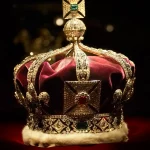 If you had one job, and that job was to safeguard the Crown Jewels from the Nazis, where (and how) would you hide the priceless gems?
If you had one job, and that job was to safeguard the Crown Jewels from the Nazis, where (and how) would you hide the priceless gems?
The first priority was to transfer the precious stones from London to a safer location, and Windsor Castle got the nod.
Even at the castle, the gems faced several threats. A bomb could blast them to smithereens, necessitating their placement in a particularly secure part of the castle.
In addition, the Wehrmacht could successfully invade Britain (the German Operation Sealion was designed to do just that), in which case Nazi search parties would have looked specifically for them.
The task of safeguarding the treasures, which included historical documents and works of art by Leonardo da Vinci and Holbein, fell to the King’s librarian, Sir Owen Morshead. His orders came directly from King George VI.
 At Windsor Castle, about 30 miles from central London, an underground chamber bolstered by steel doors was erected to host the gems.
At Windsor Castle, about 30 miles from central London, an underground chamber bolstered by steel doors was erected to host the gems.
The royal crowns had been shipped from the Tower in ordinary hat boxes. At Windsor, Morshead plucked the stones out of the crowns and stored them in a glass jar which he then inserted into an ordinary biscuit tin. The tin would not draw attention to itself, and it could easily be moved in an emergency.
Morshead also inserted a note “signed by the King to say that it had been done at his personal direction, and that it was at his wish that nobody had been told” (Shenton, p.193).
After the war, the gems were reinserted into the crown and returned to the Tower of London.

Tower of London
MORE INFORMATION
Caroline Shenton, National Treasures: Saving the Nation’s Art in World War II (2021)
https://www.bbc.co.uk/news/uk-42662795